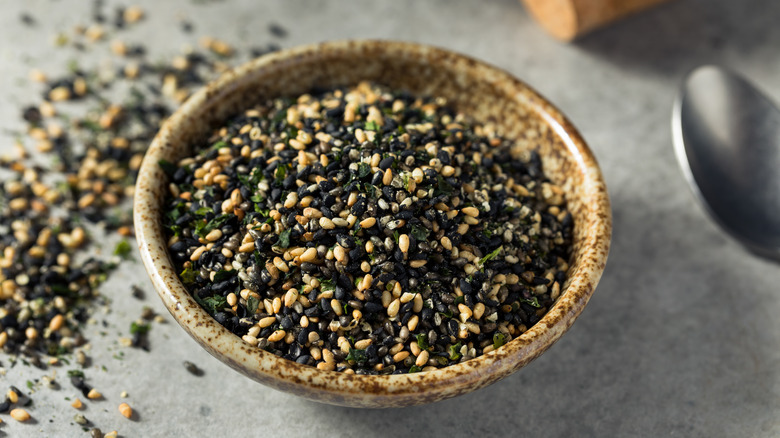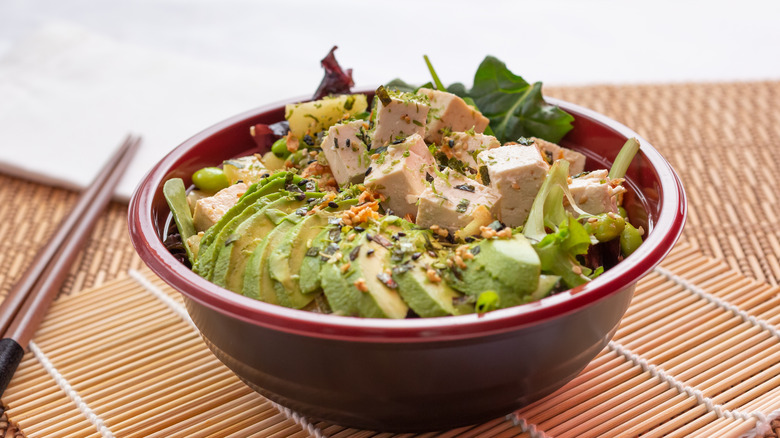This Japanese Ingredient Is A Cheat Code For Tastier Salads
We're long past the days when salads are considered a sad substitute for more exciting meals. In fact, many salads have big main course energy, and are totally cravable as a standalone dish all their own.
What matters most in creating an exciting salad isn't just the type of base you use — be it lettuce, rice, grains, noodles, or a combination, or even the toppings you choose to include, from veggies to nuts, cheeses, and beyond — but the flavor itself. And while there are limitless recipes for different dressings out there, a single Japanese ingredient may hold the key to the most unforgettable salads, bursting with flavor and absolutely never boring — and that is furikake.
This seasoning blend is super versatile and can be found in a number of varieties, and it's even simple to make at home. But what is consistent across the board is its ability to check so many flavor boxes, from sweet to savory, sometimes nutty and spicy, and always rich in umami. That means that when you sprinkle it on your next salad, you can expect a tastiness level that will leave you totally satisfied and inspired.
What is furikake, and why does it belong in your salad?
So, what is in furikake that gives it this exceptional quality ideal for salads? Most versions contain dehydrated fish and seaweed, a sweetener like sugar, as well as soy sauce, while some variations may feature an alternate dried protein like pork, beef, egg, or chicken, as well as herbs and sesame seeds. Regardless of the combination, it's a powerhouse group of ingredients packaged up as a seasoning that can be shaken from a jar when you're ready to use it.
The word "furikake" literally translates to "to sprinkle," and this multidimensional culinary secret weapon brings depth to any salad by simply being sprinkled over the top and tossed in, and is also super easy to incorporate into a dressing. Since so many layers are built right into the blend, furikake contributes a ton of flavor without a lot of extra elements, and in fact can help you streamline what you put into a salad. For example, if you're looking to eliminate elements like salty meats (think bacon or prosciutto), or cheese, the furikake can help satisfy some of what you're craving by providing umami flavors for which those elements are known. This makes it an ideal addition for vegetarian diets, and some versions are even created without fish, egg, or meat products, making for vegan-friendly options, too.
Furikake salad inspiration
Once you get a taste for furikake, you may want to add it to everything (it's even the Japanese seasoning you need to try on homemade Chex mix). But the flavors of furikake make it a perfect partner to so many salad preparations.
In a wedge salad, you can forgo pieces of bacon for a few shakes of furikake. A bowl of mixed peppery arugula, tender spinach, and hearty kale provides a sturdy base for a furikake shower along with a creamy mayo-based dressing. A classic caesar salad is known for its use of anchovies, which furikake complements with its own fishy goodness, contrasts with a little sweetness from sugar, and elevates with herbs and soy. Sesame seed furikake adds nutty depth to a grain or rice bowl, or a cold sesame soba noodle salad with bright and crunchy cucumber and bell pepper.
The savory quality of furikake is also a great counterpoint to salads that boast sweet-tart fruity vinaigrettes, or that contain fresh fruit (like a mango poke bowl), or sweeter veggies like corn or delicata squash. Dressings that feature aromatics like garlic, ginger, and onions, as well as spicy chili powder or peppercorn all work well with furikake, as do citrusy creations like yuzu vinaigrette. Topping your salad with salmon, ahi tuna, chicken, tofu, or egg can round out a super satisfying furikake-inspired meal, but even the most basic salad will be transformed with just a sprinkle of this stuff.


